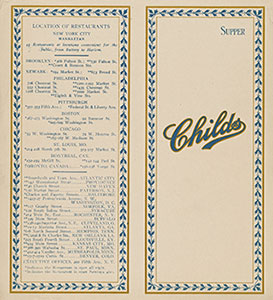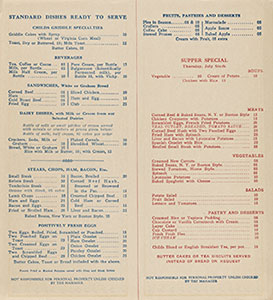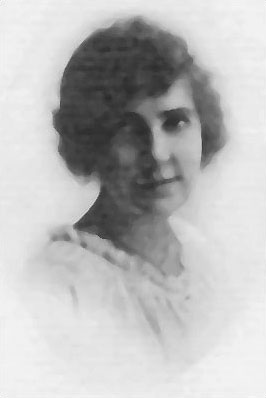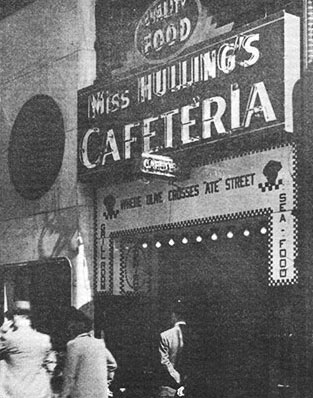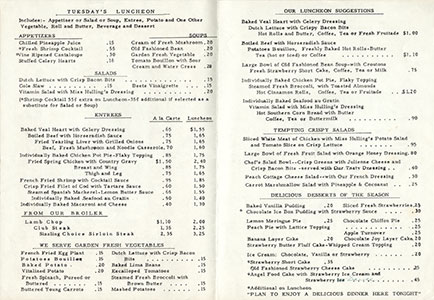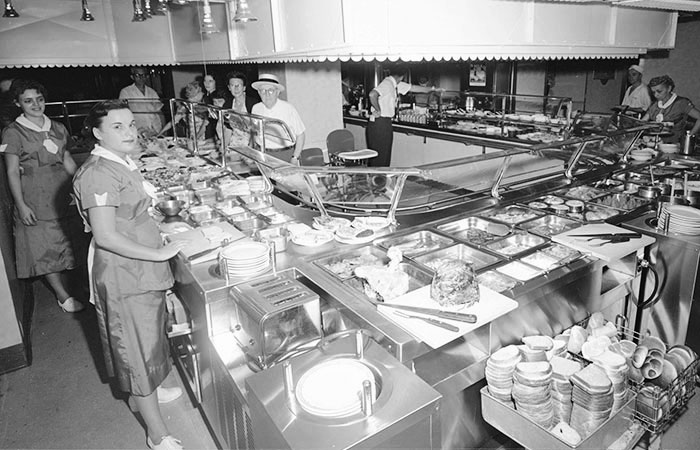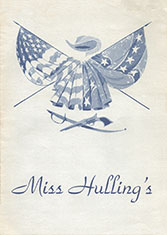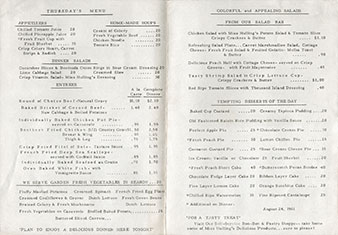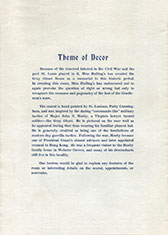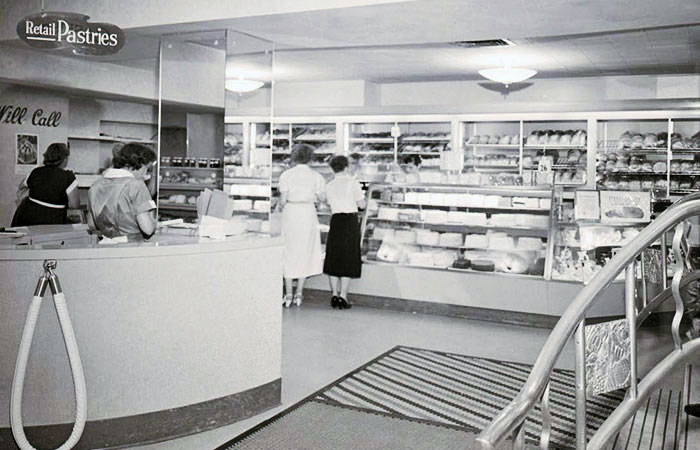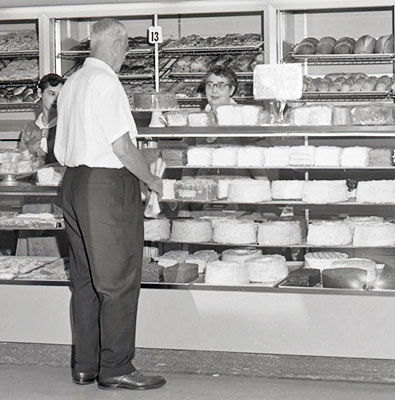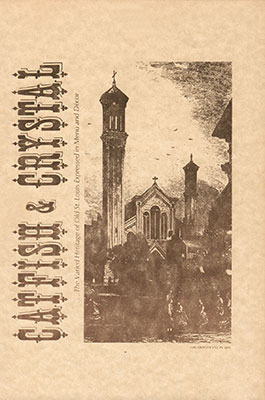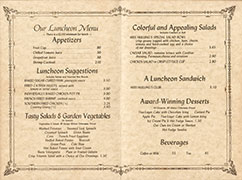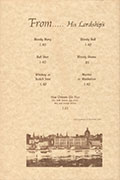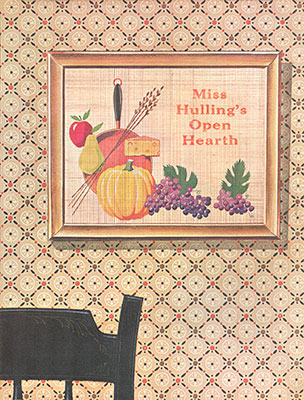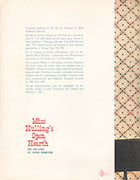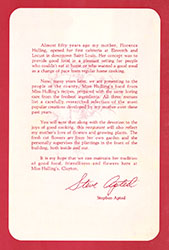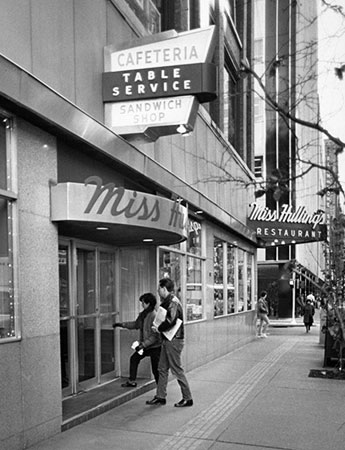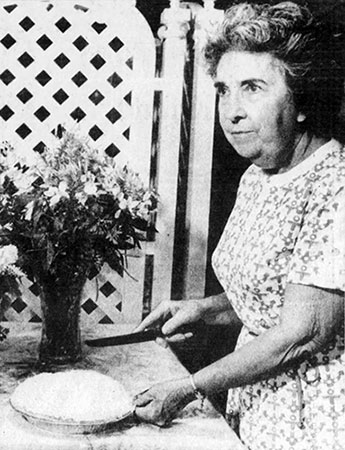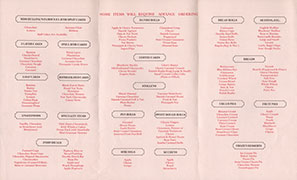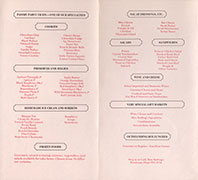|
Miss Hulling's Florence Louise Hulling was born in St. Louis on September 17, 1891 and orphaned at the age of three. She was adopted by her maternal grandparents who operated a farm near Mascoutah, Illinois, 30 miles east of St. Louis. Florence attended a one-room public school for a while, and later transferred to Holy Childhood School in Mascoutah. But her formal education ended when she was 13 and she became a full-time farm worker — cooking, dusting, sweeping, churning, making jellies and preserves, washing, ironing and occasionally working in the fields At the age of 17, Florence Hulling and her sister Catherine moved back to St. Louis.
Instead, she got a job cooking in a private home in Westminster Place. One day about a year later, she and her sister and another girl were passing a Childs restaurant on Seventh Street near Olive. In a spur of the moment decision, the trio decided to go in and ask for jobs.
Childs was part of a famed national chain of restaurants, then at its peak. Childs served good food for the money and was immaculately clean. Florence made 10 cents an hour, worked seven days a week, bought and washed her own uniforms and did her best to survive on nickel tips.
Shortly after Florence Hulling began working at Childs, she met the man she would marry. Stephen R. Apted worked out of St. Louis for a Chicago paint firm. He frequented Childs on weekends and occasionally sat at one of Florence's tables. The two became friends and, over twenty years, more than friends. They were married in 1931. Florence Hulling worked for Childs from 1910 to 1930 . . . waitress, head waitress, food checker, cashier, head of the cafeteria department. She knew so much about the restaurant business, her friends encouraged her to open a place of her own. In 1930, there was an opportunity. A basement restaurant in the Missouri Hotel at Eleventh and Locust was failing. Florence Hulling was able to take over the space by putting up the first month's rent – her whole $600 savings.
But her restaurant was a success and it made money. In 1931, when she and Stephen Apted were married, Apted quit his job and joined his wife in the operation of the restaurant. He took care of the business and financial matters and she supervised the day-to-day operations, particularly the cooking.
The Apteds' son, Stephen J., was born in 1933.
In March of 1934, they gave birth to a second cafeteria at 8th and Olive in
the basement of the Chemical Building, formerly occupied by the
Edward Benish eating place. They called it Miss Hulling's.
In 1935, General American Life gained control
of the Missouri Hotel and the Apteds moved their Missouri Cafeteria
across the street, leasing part of a building at the northwest
corner of 11th and Locust. It eventually would also be called Miss
Hulling's. Both Miss Hulling's cafeterias were a spectacular success, gastronomically and financially. Florence Hulling Apted began her day with breakfast in one of her restaurants. She spent the rest of her six-day week in and out of the kitchens.
The restaurant at Eleventh and Locust expanded sideways and upward. In the basement was a sandwich shop, on the first floor a large cafeteria, a banquet hall, a room where diners could be served at tables and a charming self-service bakery, candy shop and area with take-home frozen foods.
The Miss Hulling’s enterprise, headed by son Stephen J. Apted, expanded well beyond Florence Hulling's two cafeterias.
In 1960, the family purchased Medart’s, remodeled it extensively, and renamed it the Cheshire Inn and Lodge. In 1963, Catfish & Crystal and His Lordship's opened at 409 N 11th Street, in the same building as the Miss Hulling's cafeteria at 11th and Locust. A free carriage ride was offered with dinner. The upscale restaurant and bar served food and drink for thirty years.
In December of 1963, the 17-story Bel Air East Motel opened at Fourth and Washington in downtown St. Louis. The new motel would include two street level restaurants – Trader Vic's and Miss Hulling's Open Hearth.
Early in 1967, the Apted Hulling corporation opened a restaurant at 8215 Clayton Road, across from the Westroads Shopping Center. Initially called The Country Cupboard, and then simply The Cupboard, it exhibited an ever changing menu and decor.
In 1975, The Cupboard was
renamed Miss Hulling's, Clayton. The rebranded restaurant was a bevy
of small rooms, which budded off a warm, comfortable, antique-strewn
lobby. Waitresses wore early American attire and the menu offered
downtown cafeteria favorites. Miss Hulling's, Clayton
closed in the spring of 1978. * * * * *
* * * * * According to a 1978 Restaurant Hospitality survey, New York’s Tavern on the Green and Mama Leone were two of the nation’s top grossing independent restaurants. Guest checks averaged $14.50 and $13 respectively, with alcohol accounting for a significant portion of the tab — 30% at Tavern on the Green. At the same time, Miss Hulling’s — with its chicken livers, creamed spinach, carrot marshmallow salad and a negligible alcohol business — had an average check of $2. Yet it ranked 58th out of the 500 restaurants in the survey. * * * * *
* * * * * Stephen R. Apted died in 1969. Florence Hulling Apted remained in close touch with her restaurants every day until she was well into her 80s. Her dinner sometimes consisted of "little tastes" from the restaurant kitchen so she could be certain there was no lapse in quality. In late 1981, the Miss Hulling's Cafeteria at 8th and Olive closed its doors. It was sold to Forum Restaurants and reopened as Waid's Cafeteria.
On Tuesday, April 3, 1984, Florence Hulling Apted
died at the age of 91. Until near the end she could be seen daily at
her restaurant at 11th and Locust supervising the preparation of
food, the cafeteria line and clearing dishes from tables.
In the fall of 1986, Stephen J. Apted opened a Miss Hulling's bakery on the upper level of Plaza Frontenac. Breads and pastries were made fresh daily at Miss Hulling's main bakery downtown and delivered to Plaza Frontenac every morning.
Specialties included the chocolate split-layer and
lemon split-layer cakes that had been famous for 48 years, as well
as gourmet plum cake, Danish, pies, cakes and cookies. The Plaza Frontenac location also offered unusual salads, wine and cheeses to
compliment the bakery goods. The Miss Hulling’s cafeteria at 11th & Locust shuttered its doors for good after the close of business on Friday, October 8, 1993. Stephen J. Apted explained, "The building is crumbling around us, it’s in a high-risk area for our employees and the insurance company wants to raise our rates due to the building’s condition and age." Apted added that all attempts to find an alternate location for the cafeteria were futile. The Miss Hulling's building at 11th & Locust was demolished early in 1997. Apted closed the Miss Hulling's at Plaza Frontenac at the end of 1997. Stephen J. Apted died on March 23, 2000 at the age of 66.
Miss Hulling's split layer chocolate and lemon
cakes live on.
Copyright © 2022
LostTables.com |
||||||||||||||||||||||



